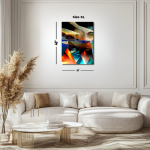Geometry of Twilight: The Cliff at Pourville Reimagined
This geometric conceptual reinterpretation of Monet’s The Cliff at Pourville, Sunset (1882) transforms the soft, impressionistic beauty of twilight into an abstract symphony of angular forms and vivid colors. The familiar landscape dissolves into intersecting planes, evoking the tension between humanity’s desire for clarity and nature’s inherent fluidity. A fragmented face symbolizes human consciousness and perception, emphasizing the subjective nature of reality. The piece meditates deeply on perception, representation, and the perpetual interplay between clarity and mystery, inviting viewers to explore the delicate geometry of human understanding.
Please see Below for Details…
Hotline Order:
Mon - Fri: 07AM - 06PM
404-872-4663
Claude Monet’s The Cliff at Pourville, Sunset (1882) originally captured a fleeting moment of coastal brilliance, defined by the delicate interplay of evening light upon rugged earth and shimmering water. Monet’s fascination with transient natural effects, particularly those of changing light and atmospheric moods, transformed a simple landscape into a profound meditation on the ephemeral nature of beauty and perception. His brushstrokes, swift yet assured, seem to trace the very path of the fading sun, turning the ordinary cliffs at Pourville into a poetic manifestation of twilight's transient glory.
This geometric conceptual reinterpretation pushes Monet’s exploration of ephemeral beauty into the realm of abstract symbolism, integrating bold geometric forms and layered imagery to craft a striking visual meditation on perception itself. Here, Monet’s original landscape of soft, impressionistic color dissolves into intersecting planes and angular shapes that transform the familiar cliffside view into an intricate puzzle of perception. The traditional boundaries between sea, sky, and cliff are deconstructed and reassembled, reflecting the complexity and fluidity inherent in our ways of seeing and understanding the world around us.
Dominating the composition, angular forms in vivid colors—rich oranges, deep blues, fiery reds, and gentle greens—intersect sharply, forming an intricate geometry that evokes both structure and chaos. These forms serve to symbolize the inherent tension between nature’s fluid beauty and humanity’s persistent urge to define, measure, and order the intangible. Monet’s original warm tones of sunset are distilled into sharp geometric shapes, intensifying the emotional contrast between the serenity of twilight and the analytical mind’s constant effort to impose clarity upon it.
Superimposed upon these shapes, subtle traces of Monet’s iconic cliffs and sea remain visible, creating a layered dialogue between realism and abstraction. The cliffs at Pourville are reduced to faint impressions, delicate remnants that seem to float within the geometric chaos, anchoring the abstraction in a recognizable landscape. This deliberate juxtaposition of impressionistic subtlety with hard-edged geometry amplifies Monet’s original message about the ephemeral nature of perception, suggesting that reality itself is composed of multiple overlapping and shifting layers, each revealing a fragment of truth.
At the visual and emotional heart of this reinterpretation lies a fragmented yet compelling face, partially hidden within the abstract landscape. The presence of this face introduces a deeply personal, introspective dimension, suggesting the human consciousness that constantly reshapes reality. Its gaze, composed of shadowed yet expressive eyes, peers directly out of the painting, engaging the viewer in an intimate dialogue about perception, understanding, and the inherent subjectivity of seeing. This fragmented face symbolizes our human presence within nature, a reflection on how deeply intertwined our identities and emotional states are with the landscapes we observe and inhabit.
Above the horizon, soft curves blend seamlessly into angular geometry, further suggesting a duality between the natural and constructed worlds. This synthesis is both symbolic and literal—capturing the emotional complexity of twilight, where day and night coexist briefly, fusing clarity and mystery. The twilight depicted here transcends mere time of day, becoming a metaphor for the liminal state of human understanding, forever caught between clarity and confusion, order and chaos, known and unknown.
The palette chosen enhances this emotional duality, retaining Monet’s evocative colors of sunset while intensifying them to represent emotional states and psychological moods. Deep oranges evoke passion and warmth, blues signify contemplation and depth, while the stark contrasts between shapes echo our inner struggles for clarity amidst life's uncertainties. The interplay of these colors within sharp geometric boundaries creates a sense of controlled emotional tension—reflecting the internal landscape of human thought, where clarity and chaos coexist in perpetual balance.
The abstract composition also invites reflection upon the nature of artistic representation itself. Monet’s original intent was always to capture impressions rather than precise realities—to depict not merely what was seen, but how it felt to witness it. This geometric abstraction furthers that intent, pushing the boundaries of visual language to suggest how deeply our perception shapes reality. Through this abstraction, Monet’s original study of ephemeral beauty and transient light transforms into an exploration of perception’s complexity and the ceaseless human attempt to understand, define, and order experiences that continually shift beyond our grasp.
In creating this reinterpretation, I sought to emphasize the interplay between human perception and nature’s inherent fluidity. Monet’s cliffs at Pourville were not just landforms, but metaphors for the boundaries of our understanding, illuminated briefly and beautifully by the fading light of day. Here, those cliffs become angular shapes—sharp, distinct, yet ultimately impermanent. They symbolize our ceaseless attempts to grasp the intangible, our efforts to make sense of the ephemeral beauty surrounding us, and our endless pursuit of meaning within a world continually shifting beneath our perceptions.
This piece thus serves as a reminder of the complexity and beauty inherent in the act of perceiving—celebrating not just nature’s transient splendor, but our own profound capacity to find meaning within its fleeting impressions. It is a tribute to Monet’s vision, extending his exploration of twilight’s beauty into a deeper meditation upon the human condition itself.
Add your review
Your email address will not be published. Required fields are marked *
Please login to write review!
Looks like there are no reviews yet.








